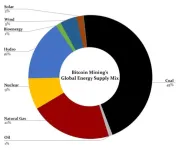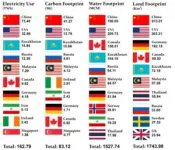(Press-News.org) American Geophysical Union
24 October 2023
AGU Release No. 23-39
For Immediate Release
This press release and accompanying multimedia are available online at: https://news.agu.org/press-release/bitcoin-mining-has-very-worrying-impacts-on-land-and-water-not-only-carbon/
AGU press contact:
Rebecca Dzombak, news@agu.org (UTC-4 hours)
Contact information for the researchers:
Kaveh Madani, United Nations University, madani@unu.edu (UTC-4 hours)
By the numbers, global bitcoin mining in 2020-2021:
Used 173 terawatt hours of electricity (more than most nations)
Emitted 86 megatons of carbon (like burning 8.5 billion pounds of coal)
Required 1.65 cubic kilometers of water (more than the domestic use of 300 million people in Sub-Saharan Africa)
Affected 1,870 square kilometers of land (1.4 times the size of Los Angeles)
Got 67% of its energy from fossil fuels, with coal contributing 45%
WASHINGTON — As bitcoin and other cryptocurrencies have grown in market share, they’ve been criticized for their heavy carbon footprint: Cryptocurrency mining is an energy-intensive endeavor. Mining has massive water and land footprints as well, according to a new study that is the first to detail country-by-country environmental impacts of bitcoin mining. It serves as the foundation for a new United Nations (UN) report on bitcoin mining, also published today.
The study reveals how each country’s mix of energy sources defines the environmental footprint of its bitcoin mining and highlights the top 10 countries for energy, carbon, water and land use. The work was published in Earth’s Future, which publishes interdisciplinary research on the past, present and future of our planet and its inhabitants.
“A lot of our exciting new technologies have hidden costs we don’t realize at the onset,” said Kaveh Madani, a Director at United Nations University who led the new study. “We introduce something, it gets adopted, and only then do we realize that there are consequences.”
Madani and his co-authors used energy, carbon, water and land use data from 2020 to 2021 to calculate country-specific environmental impacts for 76 countries known to mine bitcoin. They focused on bitcoin because it’s older, popular and more well-established/widely used than other cryptocurrencies.
Madani said the results were “very interesting and very concerning,” in part because demand is rising so quickly. But even with more energy-efficient mining approaches, if demand continues to grow, so too will mining’s environmental footprints, he said.
Electricity and carbon
If bitcoin mining were a country, it would be ranked 27th in energy use globally. Overall, bitcoin mining consumed about 173 terawatt hours of electricity in the two years from January 2020 to December 2021, about 60% more than the energy used for bitcoin mining in 2018-2019, the study found. Bitcoin mining emitted about 86 megatons of carbon, largely because of the dominance of fossil fuel-based energy in bitcoin-mining countries.
The environmental impact of bitcoin mining fluctuates along with energy supply and demand in a country. When energy is inexpensive, the profitability of mining bitcoin goes up. But when energy is expensive, the value of bitcoin must be high enough to make the cost of mining worth it to the miner, whether it’s an individual, a company or a government.
China, the U.S. and Kazakhstan had the largest energy and carbon footprints in 2020-2021.
Water
Globally, bitcoin mining used 1.65 million liters (about 426,000 gallons) of water in 2020-2021, enough to fill more than 660,000 Olympic-sized swimming pools. China, the U.S. and Canada had the largest water footprints. Kazakhstan and Iran, which along with the U.S. and China have suffered from water shortages, were also in the top-10 list for water footprint.
“These are very, very worrying numbers,” Madani said. “Even hydropower, which some countries consider a clean source of renewable energy, has a huge footprint.”
Land use
The study analyzed land use by considering the area of land affected to produce energy for mining. The land footprint of server farms is negligible, Kaveh said. The global land use footprint of bitcoin mining is 1,870 square kilometers (722 square miles), with China’s footprint alone taking up 913 square kilometers (353 square miles). The U.S.’ land footprint is 303 square kilometers (117 square miles), and likely growing while China’s is shrinking.
Most impacted countries
China and the United States, which have two of the largest economies and populations in the world, take the top two spots across all environmental factors. A mix of other countries make up the other 8 spots in the top 10. Kazakhstan, Malaysia, Iran and Thailand — countries to which servers are outsourced and, in some cases, where cryptocurrency mining is subsidized by the government — appear as well. Canada, Germany and Russia have some of the largest footprints across all categories. Each country engaged in large-scale bitcoin mining affects countries around the world by their carbon emissions, Kaveh noted.
But the benefits of bitcoin mining may not accrue to the country, or the individuals, doing the work. Cryptocurrency mining is an extractive and, by design, difficult to trace process, so geographic distribution of environmental impacts cannot be assumed to be a map of the biggest digital asset owners.
“It’s hard to know exactly who is benefiting from this,” Madani said. “The issue now is who is suffering from this.”
Already, some countries have potentially seen their resources impacted by cryptocurrency mining. In 2021, Iran faced blackouts. The government blamed bitcoin mining for excessively draining hydropower during a drought and periodically banned the practice.
China in June 2021 banned bitcoin mining and transactions in the country; other countries, such as the U.S. and Kazakhstan, have taken up the slack and had their shares in bitcoin increase by 34% and 10%, respectively.
Madani said the study is not meant to indict bitcoin or other cryptocurrency mining. “We’re getting used to these technologies, and they have hidden costs we don’t realize,” he said. “We want to inform people and industries about what these costs might be before it’s too late.”
Notes for journalists:
This study is published in Earth’s Future, an open-access journal. View and download a pdf of the study here. The authors’ policy-related comments do not necessarily reflect the views of the American Geophysical Union.
This study provides the peer-reviewed data serving as a foundation for the U.N. report, “The Hidden Environmental Cost of Cryptocurrency: How Bitcoin Mining Impacts Climate, Water and Land,” published on the same day as this study. The report includes additional data that have not been peer-reviewed by Earth’s Future. View the U.N. press release here.
Paper title:
“The environmental footprint of bitcoin mining across the globe: Call for urgent action”
Authors:
Sanaz Chamanara, United Nations University Institute for Water, Environment and Health, Hamilton, Ontario, Canada
S. Arman Ghaffarizadeh, Department of Mechanical Engineering, Carnegie Mellon University, Pittsburgh, PA, USA
Kaveh Madani (corresponding author), Director of the United Nations University Institute for Water, Environment and Health, Hamilton, Ontario, Canada
#
AGU (www.agu.org) is a global community supporting more than half a million advocates and professionals in Earth and space sciences. Through broad and inclusive partnerships, AGU aims to advance discovery and solution science that accelerate knowledge and create solutions that are ethical, unbiased and respectful of communities and their values. Our programs include serving as a scholarly publisher, convening virtual and in-person events and providing career support. We live our values in everything we do, such as our net zero energy renovated building in Washington, D.C. and our Ethics and Equity Center, which fosters a diverse and inclusive geoscience community to ensure responsible conduct.
END
Bitcoin mining has “very worrying” impacts on land and water, not only carbon, UN-led study reveals
Every country has a different environmental bitcoin mining footprint, largely depending on its energy sources. China and the United States have the largest bitcoin mining footprints, a new United Nations-led study reveals
2023-10-24
ELSE PRESS RELEASES FROM THIS DATE:
How eggs of the Zika-carrying mosquito survive desiccation
2023-10-24
Eggs of the mosquito that carries Zika virus can tolerate extended desiccation by altering their metabolism, according to a new study publishing October 24th in the open access journal PLOS Biology by Anjana Prasad, Sunil Laxman, and colleagues at the Institute for Stem Cell Science and Regenerative Medicine in Bengaluru, India and the Indian Institute of Technology in Mandi, India. The finding offers potential new ways to control the spread of this mosquito.
Cells are made mostly of water, and desiccation is a potentially fatal event for any organism, since the structures of many proteins and other cellular molecules are dependent ...
How mosquito-controlling bacteria might also enhance insect fertility
2023-10-24
A new study reveals biological mechanisms by which a specific strain of bacteria in the Wolbachia genus might enhance the fertility of the insects it infects—with potentially important implications for mosquito-control strategies. Shelbi Russell of the University of California Santa Cruz, US, and colleagues report these findings in the open access journal PLOS Biology on October 24th.
Different strains of Wolbachia bacteria naturally infect a number of different animals worldwide, such as mosquitos, butterflies, and fruit flies. Wolbachia can manipulate the fertility of their ...
Ancient landscape discovered beneath East Antarctic Ice Sheet
2023-10-24
The research team, led by Durham University, UK, used satellite data and radio-echo sounding techniques to map a 32,000 km2 area of land underneath the vast ice sheet.
They discovered a landscape that appears to have been formed by rivers at least 14 million years ago and possibly even before the initial growth of the East Antarctic ice around 34 million years ago.
This newly discovered landscape consists of ancient valleys and ridges, not dissimilar in size-and-scale to the glacially-modified landscape of North Wales, ...
Cleveland Clinic selected by Wellcome Leap for Two Quantum Computing Research Projects
2023-10-24
Cleveland Clinic has been selected by Wellcome Leap to lead a quantum computing research project, while also playing a significant role in another led by Algorithmiq — both in collaboration with IBM Quantum.
The two contracts were won through Wellcome Leap’s Quantum for Bio Challenge, which will award up to $40 million to 12 researchers globally for research focused on accelerating the development of quantum computing applications for healthcare. Wellcome Leap is a U.S.- based non-profit organization founded by the Wellcome Trust to accelerate and increase ...
SLAC scientists shed light on potential breakthrough biomedical molecule
2023-10-24
Scientists from the Department of Energy’s SLAC National Accelerator Laboratory have gained valuable insights into producing nitroxide, a molecule with potential applications in the biomedical field. While nitric oxide (NO) has long been on researchers' radar for its significant physiological effects, its lesser-known cousin, nitroxide (HNO), has remained largely unexplored.
The study, published recently in the Journal of the American Chemical Society, was born out of a joint endeavor between teams at SLAC’s Linac Coherent Light Source (LCLS) X-ray laser and Stanford ...
Japanese registry finds use of IVUS in coronary interventions reduces mortality and need for coronary bypass surgery
2023-10-24
SAN FRANCISCO – A novel study conducted by a Japanese multicenter registry has revealed the significant benefits of using intravascular ultrasound (IVUS) in coronary intervention procedures. The comprehensive analysis, which focused on enhancing patient outcomes, has provided valuable insights into the effectiveness of IVUS in improving the success rates of these interventions.
The study, titled "Enhancing coronary intervention outcomes with the use of intravascular ultrasound: A comprehensive analysis of long-term benefits in Japanese multicenter registry," sheds light on the positive ...
NIH Kids First program releases nine new data sets for childhood cancer and congenital disorder research
2023-10-24
Philadelphia, PA., October 24, 2023
WHO: The Gabriella Miller Kids First Pediatric Research Program (Kids First), an initiative of the National Institutes of Health (NIH)
WHAT: Kids First announces the release of nine robust new pediatric research datasets spanning childhood cancers, congenital disorders, and cross-condition data. New publicly available datasets include:
PEDIATRIC CROSS-CONDITION
Kids First and INCLUDE: Down Syndrome, Heart Defects, and Acute Lymphoblastic Leukemia
Principal ...
Case report shows promising results using transcranial magnetic stimulation for post-stroke ataxia
2023-10-24
In a new case report, researchers at UCLA Health describe promising results using repetitive transcranial magnetic stimulation (rTMS) in the management of post-stroke cerebellar ataxia, a debilitating condition marked by impaired coordination and balance.
Cerebellar ataxia describes a group of neurological disorders that affect coordination, balance, and control of muscle movements. It results from damage or dysfunction of the cerebellum, a part of the brain responsible for coordinating voluntary movements. Ataxia can manifest as unsteady walking, difficulties with fine motor skills, and problems with speech, ...
$9 million award from the Department of Defense will fund groundbreaking FutureG research
2023-10-24
Lingjia Liu, professor of electrical and computer engineering who is also an inaugural faculty member at the Virginia Tech Innovation Campus, has been awarded the Mobile Distributed Multiple-Input, Multiple-Output (Mobile dMIMO) project by the U.S. Department of Defense’s (DoD’s) Office of the Under Secretary of Defense for Research and Engineering (OUSD(R&E)) as part of its flagship FutureG program. The Mobile dMIMO project consists of three phases, with $9 million total planned funding — $1.5 million is for Phase 1 of the project. The Mobile dMIMO project represents one ...
Smartphone attachment could increase racial fairness in neurological screening
2023-10-24
Engineers at the University of California San Diego have developed a smartphone attachment that could enable people to screen for a variety of neurological conditions, such as Alzheimer’s disease and traumatic brain injury, at low cost—and do so accurately regardless of their skin tone.
The technology, published in Scientific Reports, has the potential to improve the equity and accessibility of neurological screening procedures while making them widely available on all smartphone models.
The attachment fits over a smartphone’s camera and improves its ...
LAST 30 PRESS RELEASES:
58% of patients affected by 2022 mpox outbreak report lasting physical symptoms
Golden Gate method enables rapid, fully-synthetic engineering of therapeutically relevant bacteriophages
Polar weather on Jupiter and Saturn hints at the planets’ interior details
Socio-environmental movements: key global guardians of biodiversity amid rising violence
Global warming and CO2 emissions 56 million years ago resulted in massive forest fires and soil erosion
Hidden order in quantum chaos: the pseudogap
Exploring why adapting to the environment is more difficult as people age
Society for Laboratory Automation and Screening welcomes new scientific director: Madeline M. Farley, Ph.D.
Austrian cow shows first case of flexible, multi-purpose tool use in cattle
Human nasal passages defend against the common cold and help determine how sick we get
Research alert: Spreading drug costs over the year may ease financial burden for Medicare cancer patients
Hospital partnership improves follow up scans, decreases long term risk after aortic repair
Layered hydrogen silicane for safe, lightweight, and energy-efficient hydrogen carrier
Observing positronium beam as a quantum matter wave for the first time
IEEE study investigates the effects of pointing error on quantum key distribution systems
Analyzing submerged fault structures to predict future earthquakes in Türkiye
Quantum ‘alchemy’ made feasible with excitons
‘Revoice’ device gives stroke patients their voice back
USF-led study: AI helps reveal global surge in floating algae
New method predicts asthma attacks up to five years in advance
Researchers publish first ever structural engineering manual for bamboo
National poll: Less than half of parents say swearing is never OK for kids
Decades of suffering: Long-term mental health outcomes of Kurdish chemical gas attacks
Interactional dynamics of self-assessment and advice in peer reflection on microteaching
When aging affects the young: Revealing the weight of caregiving on teenagers
Can Canada’s health systems handle increased demand during FIFA World Cup?
Autistic and non-autistic faces may “speak a different language” when expressing emotion
No clear evidence that cannabis-based medicines relieve chronic nerve pain
Pioneering second-order nonlinear vibrational nanoscopy for interfacial molecular systems beyond the diffraction limit
Bottleneck in hydrogen distribution jeopardises billions in clean energy
[Press-News.org] Bitcoin mining has “very worrying” impacts on land and water, not only carbon, UN-led study revealsEvery country has a different environmental bitcoin mining footprint, largely depending on its energy sources. China and the United States have the largest bitcoin mining footprints, a new United Nations-led study reveals







